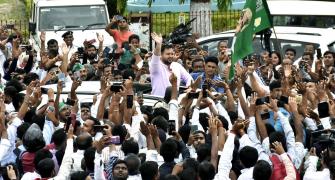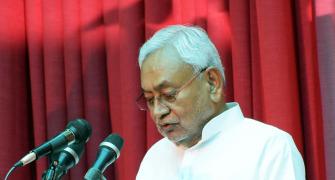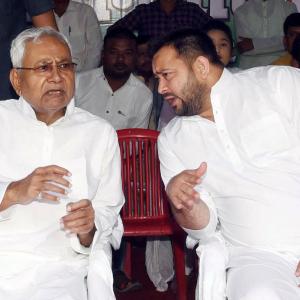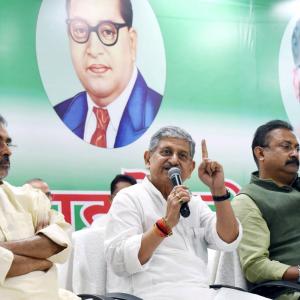Various indicators make it amply clear that there are grave challenges facing the new government of Chief Minister Nitish Kumar, reports Indivjal Dhasmana.

As allegations fly thick and fast in Bihar after the Janata Dal-United decided to break its coalition with the Bharatiya Janata Party and tie-up with the Rashtriya Janata Dal and its allies instead, it is governance that appears to be crying for attention.
Various indicators make it amply clear that there are grave challenges facing the new government of Chief Minister Nitish Kumar.
Bihar, the third most populous state in the country, is also the poorest, according to the NITI Aayog’s multidimensional poverty index (MPI). On this metric, every second person was poor in the state in 2015-16 against one in every four at the all-India level.
The gravity of the issue can be gauged from the fact that 42.16 per cent of the second poorest state -- Jharkhand -- were categorised as poor, almost 10 percentage points less than the state it was part of before 2000.
The MPI is based on three dimensions -- health, education, and standard of living -- with each having a weighting of one-third in the index.
These dimensions are further based on 12 segments -- nutrition, child and adolescent mortality, antenatal care, years of schooling, school attendance, cooking fuel, sanitation, drinking water, electricity, housing, assets, and bank accounts.
One may argue that the MPI cited above is for the year 2015-16 and that much has changed since then. Other indicators from National Family Health Survey (2019-21), however, show that Bihar had the lowest female and male literacy rates in the 15-59 age group, often referred to as adults. Besides, it had the second highest infant mortality rate.
Though NFHS has different samples for states, these do provide broad indicators on various aspects.
The picture is no different when it comes to economic indicators. Bihar’s per capita income was the lowest among states in 2020-21, accounting for just one-third of the national average.
The goods and services tax (GST) was supposed to boost the revenue of the poor states, since it is a destination-based system. However, Bihar's own tax revenue as a per cent of revenue receipts ranged between 20-24 per cent in the past three years, the same as it was in the pre-GST period. For instance, the state had this ratio at 22.48 per cent in 2016-17, a pre-GST period and it is projected at 21 per cent in the current financial year.
Bihar’s debt constitutes more than one-third of its gross state domestic product (GSDP). According to a study by the Reserve Bank of India (RBI), Bihar is part of five states that are highly stressed in terms of the debt-GSDP ratio. The others are Kerala, Punjab, Rajasthan, and West Bengal.
According to the study, Bihar is also part of four states that exceeded both debt and fiscal deficit targets for 2020-21 set by the 15th Finance Commission. The others are Andhra Pradesh, Rajasthan, and Punjab.
One could question why the interest payments as a per cent of revenue receipts are not as high as in the case of some other states like Andhra Pradesh, Gujarat, Haryana, Karnataka, Kerala, Madhya Pradesh, Maharashtra, Punjab, Rajasthan, Tamil Nadu, Telangana, Uttar Pradesh, and West Bengal. In the case of Haryana, Punjab, Tamil Nadu, and West Bengal, it is over 20 per cent, according to the RBI study.
This is because Bihar’s debt-GSDP ratio was not much before 2018-19 in Bihar. For instance, it was 19.6 per cent during 2016-17 and 23.5 per cent the next year. The redemption of borrowings made after that will jack up interest payments figures for Bihar, too, depending on tenures and coupon rates.
If one combines the two other committed expenditures -- pensions and salaries -- with interest payments, the outgo is higher than the state’s own revenues (tax, non-tax, and non-debt capital receipts combined) by around 47 per cent. This means it relies entirely on devolution and grants from the Centre, apart from borrowings to finance its capital and other expenditures, including on many social welfare schemes.
This may prove a hurdle for Bihar’s Deputy Chief Minister Tejashwi Yadav’s promise to provide “bumper” jobs to poor youth within a month.
Despite the poor deficit and debt situation, Bihar is showing a revenue surplus in 2022-23. However, one must take this figure with a pinch of salt. This is because the state projected its revenue balance to be in surplus at 1.2 per cent in 2021-22 (Budget Estimates), but the revised projection in the latest Budget pegged it at a deficit of 5.5 per cent.
Also, capex in 2022-23 is projected to decline by 23 per cent, compared with the Revised Estimates (RE) of the previous year, while revenue expenditure would fall by seven per cent. If this happens, Bihar’s economy may face a grave crisis. However, RE expenditures in Bihar are generally exaggerated, while revenues are more or less accurate. As such, the next year’s BE shows a bit of pessimism in expenditure as the base is high.











